
|

|
|
Home Site Search Contact Us Subscribe
|
|
|
A Treasure Reborn: The Currier Museum of Art by Ann Beha Architects Manchester, New Hampshire: An important cultural resource reopens its doors after a thoughtful renovation and expansion. By ArchNewsNow September 23, 2008 Considered one of the North America’s finest regional museums and listed on the National Register of Historic Places, the Currier Museum of Art in Manchester, New Hampshire, is the only public art museum in the state. Its history and collections are known internationally, and include European and American paintings, decorative arts, photographs, and sculpture, including works by Picasso, Monet, O'Keeffe, Wyeth, and LeWitt – an off-site holding is the 1950 Frank Lloyd Wright-designed Zimmerman House.
In March 2008, the museum reopened its doors with a 73,000-square-foot, $14 million renovation and expansion designed by Boston-based Ann Beha Architects (ABA). The project includes 40,000 square feet of renovation and 33,000 square feet of new construction, and encompasses two city blocks with outdoor space for sculpture and events. The expansion doubles the amount of space for exhibits, programs, and visitors services, while maintaining the museum’s appealing, intimate scale. In the initial planning stages, alternate sites were considered, but expanding the museum on its existing urban site was fundamental to the sustainable approach.
The new additions offer a contemporary interpretation of the original museum building’s restrained classicism, and are scaled to maintain the prominence of the original 1929 building designed by Tilton & Githens. Two galleries, added in 1982 by Hardy Holzman Pfeiffer, had re-oriented entry to the north side adjacent to parking in the service of accessibility.
“Early in the process, we looked at many alternatives for adding to the landmark, and settled on two separate additions which preserve the prominence of the original 1929 building, and incorporate two1982 additions,” says Pamela W. Hawkes, FAIA, ABA’s Principal-in-Charge of the project. “The placement of new spaces and reconsideration of existing ones establishes a clear path through the galleries which builds on the Beaux Arts symmetry of the original plan. The new entrance and Winter Garden extend an axis of public spaces centered on the original two-story interior court, punctuated by glimpses of art as well as views into public spaces and the city beyond.”
The north addition features a new main lobby with ticketing area, expanded museum shop, and visitor services. On the south, three new galleries surround an enclosed Winter Garden, offering a year-round space for the café, receptions, and performances. From the Winter Garden, a stair leads to a new 180-seat auditorium, two classrooms, and administrative offices. Behind the scenes, there’s a new loading area and freight elevator for delivery and set-up for the special exhibits.
The new south addition is clad in glass and a rain screen of honed brown terra cotta tiles which harmonize with the limestone and buff brick of the 1929 building and the 1982 additions, respectively. Porticos on the north and south are constructed of zinc, aluminum, and fritted glass, and recall the proportions of the entrance portico.
On the interior, cherry paneling and dark basalt provide warmth and richness that recall the Art Deco details of the original building. Natural light from skylights and large walls of glass enlivens public spaces, while carefully protecting the artwork within.
“The primary reason for the expansion is to show more of the collections and be able to accommodate audiences,” says Director Susan Strickler. “We knew the quality of the collections deserved a wider audience and a wider cross-section of the state.”
KEY DESIGN FEATURES:
Exterior: Stone details of the original building façade have been reinterpreted in contemporary materials on the new addition facing the city. The zinc-sheathed cornice aligns with the frieze, while the traditional granite base is transformed into a glazed clerestory, lighting lower level offices and the auditorium.
Visibility & Welcome: Visitors enter a drop-off court punctuated by “Origins,” a dramatic sculpture by Mark di Suvero, acquired especially for the space as an impressive sign post for the museum. The all-glass north façade unites the 1980s additions and draws visitors into the museum.
Lobby: The new lobby incorporates visitor services as well as waiting areas for groups assembling to tour the museum’s Frank Lloyd Wright Zimmerman House. Porticos on either side, part of the 1982 additions, offer views into the permanent collection galleries.
New South Gallery: Designated for sculpture and other collections not sensitive to light, the South Gallery provides a rare opportunity to reveal the museum’s collections to passersby through large expanses of glass, as well as offering vistas from the interior to the community.
Winter Garden: The original entrance, with mosaics depicting The Arts created by Salvatore Lascari, is now the focal point of the Winter Garden. Connections to the façade were kept to a minimum, and skylights filled with clear glazing were incorporated to preserve the play of light and shadow on the limestone carvings.
As the central gathering space for the Museum, the Winter Garden can easily be configured for lectures and events up to 200 people. The south wall is dominated by two murals, among the last created by artist Sol LeWitt, were inspired by the mosaics. A lion’s head sculpture, retrieved from the fountain at the original entrance, now marks the stair and ramp leading to the new galleries.
Special Exhibitions Gallery: While carefully scaled to match galleries in the historic building, the new east and west galleries provide the precise climate control required for traveling exhibits, not possible in the existing building or earlier additions.
Education: From the Winter Garden, visitors descend an open stair to the lower level. With 20% of the museum’s audience coming from school groups, the lower level is an active space. Visits generally include 60-80 students and begin with orientation in the auditorium and end with activities in two classrooms. With seating for 175, the auditorium provides flexible space for lectures, film screenings, and musical performances.
Project Credits: Client: The Currier Museum of Art Architect: Ann Beha Architects Project Team: Pamela W. Hawkes FAIA (Principal-in-Charge), Scott Aquilina AIA (Project Manager), Robert Genova AIA (Project Architect), Andrew Wang AIA, Nicole Groleau, Andrew Grote, Robert Mercer, Ben Wan (Project Team)
Contractor: Harvey Construction Corporation of NH Structural Engineer: LeMessurier Consultants Mechanical Engineer: Exergen Corporation Electrical, Fire Protection, Plumbing Engineer: Rist-Frost-Shumway Engineering, P.C. (1929 original building, 1982 additions, new construction) Landscape Architect: Richard Burck Associates, Inc. Geo-technical Engineer: Miller Engineering & Testing Inc. Specifications Consultant: Wil-Spec Architectural Specifications Lighting Designer: Hefferan Partnership Lighting Design Acoustician: Acentech, Inc. Code Consultant: Hughes Associates, Inc. Graphic Designer: Wojciechowski Design Exhibit Designer: Clifford LaFontaine, Inc. Photographer: Jonathan Hillyer Photography, Inc.
Boston-based Ann Beha Architects is engaged in contemporary design and the preservation and adaptive re-use of landmark buildings throughout the United States. The firm’s design honors include awards from the American Institute of Architects, the Boston Society of Architects, the National Trust for Historic Preservation, the Boston Preservation Alliance, and the Victorian Society in America. Representative projects include the New Britain Museum of American Art in New Britain, CT; the Daniel Arts Center at Bard College at Simon’s Rock in Great Barrington, MA; Jordan Hall at the New England Conservatory of Music in Boston; Hensel Hall at Franklin and Marshall College; and projects for the Boston Symphony Orchestra at Symphony Hall and the Tanglewood Music Center.
Also see:
Northwest Expansion:
The Portland Art Museum by Ann Beha Architects and SERA Architects
The Daniel Performing
and Visual Arts Center, Simon's Rock College of Bard by Ann Beha Architects
|
(click on pictures to enlarge)  Jonathan Hillyer The Currier Museum of Art: new north entrance highlights Mark di Suvero’s “Origins”; the all-glass north façade unites the 1980s additions 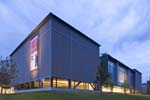 Jonathan Hillyer New south addition at night shows off the auditorium and offices below 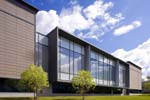 Jonathan Hillyer South addition by day  Ann Beha Architects South façade prior to the renovation and expansion 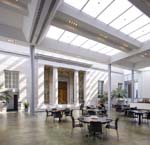 Jonathan Hillyer The Winter Garden faces the original 1929 façade with mosaics by Salvatore Lascari 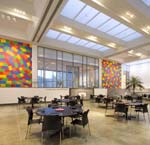 Jonathan Hillyer The Winter Garden’s south wall sports murals by Sol leWitt 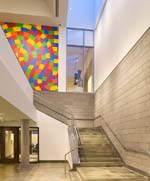 Jonathan Hillyer The stairway from Winter Garden leads to the lower level offices, classrooms, and auditorium 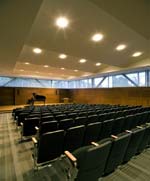 Jonathan Hillyer The 175-seat auditorium 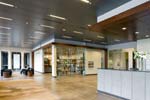 Jonathan Hillyer New main lobby, ticketing, and museum shop 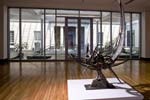 Jonathan Hillyer South Gallery looking into the Winter Garden 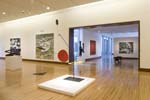 Jonathan Hillyer Special Exhibitions Gallery looking into the South Gallery and Winter Garden 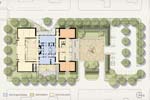 Ann Beha Architects Site plan and main level floor plan; blue = original 1929 building; peach = 1982 additions; yellow = new construction 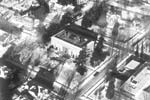 Ann Beha Architects Aerial of original museum circa 1930 |
© 2008 ArchNewsNow.com